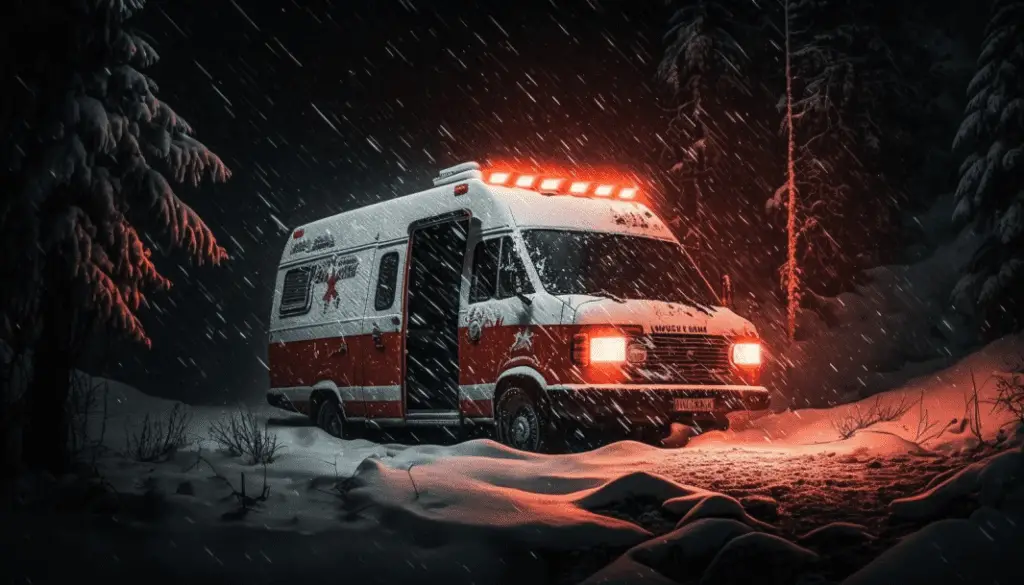Going on camping and road adventures is always a thrilling and enjoyable experience. However, as the cold weather approaches, it’s imperative to get your camper van ready for the harsh winter elements. Proper winterization is a crucial part of preserving your camper van’s longevity and shielding it from any potential harm. This guide will give you a complete understanding of the measures you need to undertake to winterize your camper van effectively.
Steps On How To Winterize Your Camper Van:
Step 1: Clean and Empty the Van
The first and foremost step in winterizing your camper van is to give it a thorough cleaning. This will not only help maintain the interior’s appearance but also prevent mold and mildew growth during the winter months.
Here are a few steps to follow when cleaning your camper van:
- Clear out all food and personal belongings, leaving no trace of perishable items behind to deter any foul odors or unwanted visitors.
- Thoroughly sanitize the inside of your camper van, paying close attention to surfaces such as countertops, sinks, refrigerators, stoves, and floors. Utilize a powerful cleaning solution to eliminate any bacteria or germs.
- Completely empty all waste tanks, including the gray and black water tanks. Flush the toilets and sinks to guarantee that all water has been evacuated from the plumbing system.
- Check for any leaks or damages in the roof or walls, and make any necessary repairs before winterizing.
Once you have thoroughly cleaned the camper van, you can start the winterization process with peace of mind knowing that your van is clean and ready for storage.
Step 2: Protect the Plumbing System
Your camper van’s plumbing system is particularly susceptible to the damaging effects of freezing temperatures, which can result in costly repairs. To safeguard it, you must drain the water heater, hot water tank and fresh water tank. Here’s the procedure:
- Empty and Rinse the Black and Gray Tanks. Wastewater should not be left in your RV over the winter. Not only could those reservoirs become a reproduction place for an assortment of bacteria, but the liquid can also freeze and create issues. Clear both, opening with the black water reservoir and then the gray water tanks. After both tanks have been emptied, use a dark tank cleaner or a cleaning wand to cleanse the black tank and sewer hose.
- Drain the freshwater tank by turning off the pump and opening the drain valve. You may need to turn off the city water inlet to the van and open all the faucets to ensure that all the water is removed.
- Drain the water heater by turning off the electricity or gas supply and opening the drain valve and pressure relief valve. Allow the water to completely drain from the tank.
- Remove the inline water filters, then replace housing.
- Don’t forget to drain your outdoor shower if you have one.
- If your RV has an icemaker or washing machine, check your owner’s manual for specific winterizing instructions.
In addition to draining the tanks, you can also add antifreeze to the plumbing system to prevent it from freezing. About two gallons of antifreeze (RV Pink antifreeze) is used in the hot water tank and the hot water heater, fresh water tank and the pipes. Make sure to follow the manufacturer’s instructions for adding the antifreeze to your camper van’s plumbing system.
Supplies needed for the antifreeze method:
- Depending on the size of your RV, you’ll need 2-3 gallons of non-toxic RV antifreeze. See the product on Amazon.
- Black tank flush wand or nozzle.
- If your camper doesn’t already have a water heater bypass kit, you can purchase one.
- The tools needed to remove and reinstall the drain plug on a water heater
- Water pump converter kit to connect to the inlet side of the water pump
- Air compressor
By taking the time to protect your camper van’s plumbing system, you can ensure that it will be in good condition when you are ready to hit the road again in the spring.
Step 3: Secure the Windows, Doors and Vents
To prevent any drafts or moisture from entering your camper van, you need to make sure that all the windows, doors and vents are properly secured. Here’s how:
- Windows: Inspect all the windows for any cracks or leaks and seal them promptly if you discover any. Weather stripping or silicone caulk can be utilized to achieve this.
- Doors: Evaluate the door gaskets and replace them if needed. Ensure that the door is firmly latched and there are no gaps or leaks around it.
- Vents: Assess all the vents and make sure they are securely closed and sealed. For roof vents, consider covering them with vent covers to prevent moisture and debris from entering.
Securing your camper van’s windows, doors and vents will help to keep the interior warm and dry, and prevent any damage that might occur due to drafts or moisture. This is an important step in the winterization process that should not be overlooked.
Step 4: Store the Batteries Properly
The batteries in your camper van need to be properly stored during the winter months in order to maximize their longevity and performance. To do this, you should first:
- Disconnect the batteries from your camper van and store them in a dry, temperate location.
- Using a mixture of baking soda and water, clean the battery terminals and terminal posts to eliminate any corrosion. Thoroughly dry the terminals before putting the batteries away.
- Place the batteries on a level surface and cover them with a battery cover to offer additional protection against moisture and dirt.
- If you have a lead-acid battery, make sure it is topped off with distilled water, and that it is charged at around 50% before storage.
By taking these steps to properly store your camper van’s batteries, you can help extend their life so that they are ready to go when you are ready for your next adventure in the spring.
Some other storage tips
When preparing your camper van for storage over the winter months, there are a few simple steps you can take to make sure it stays in good condition.
- Cover the van with a tarp or custom cover to protect all seals and paint from weathering due to exposure to the elements. If possible, park the van in a garage or carport for maximum protection from the elements.
- Remove any food or food smells as these may attract pests such as rodents. Check on your van every couple of weeks during winter storage to ensure that no pests have invaded your engine compartment or elsewhere in the van.
- To prevent mold and odor build-up, leave your fridge door propped open during storage so air can circulate freely through the interior.
By following these basic tips for winterizing your camper van, you can help ensure its longevity and protect your investment.
FAQs:
How often should I winterize my camper van?
It is advisable to winterize your camper van each year, especially if you reside in a region with severe winter weather conditions. This precautionary measure helps to shield your camper van from the harsh cold and potential damage caused by freezing. Winterizing your camper van annually is a simple process that can be completed in a matter of hours, and it helps to prolong the lifespan of your vehicle while ensuring it remains in good working condition.
It is worth mentioning that even if you do not live in an area with harsh winter weather conditions, it is still recommended to winterize your camper van to protect it from any possible damage that may arise if you do embark on a journey to such a region.
Is it necessary to drain the water tanks when winterizing my camper van?
It is indeed essential to empty the water tanks when winterizing your camper van. This is a crucial step in the winterization process as it helps prevent the water in the tanks from freezing, thereby avoiding damage to the plumbing system. When water freezes, it expands, putting immense pressure on pipes and tanks, which can result in cracks and leaks.
Emptying the water tanks also helps prevent the growth of any harmful bacteria that can accumulate in stagnant water. It’s also a good practice to add antifreeze to the fresh water tank to prevent the water from freezing and to lubricate the plumbing system. By following these steps, you can safeguard your camper van and ensure it is in prime condition when winter is over.
Can I use antifreeze in the fresh water tank?
Your camper van’s fresh water tank can be winterized with antifreeze. It is common practice to add antifreeze to the fresh water tank when winterizing a vehicle to prevent the water from freezing, resulting in plumbing system damage. Use a food-grade, non-toxic antifreeze that is safe for potable water systems.
Antifreeze is typically added to the fresh water tank by running it through the plumbing system to ensure that all water lines are protected. By doing this, you can avoid any damage caused by freezing temperatures by lubricating the plumbing system.
To ensure your camper van is protected during the winter, follow the manufacturer’s instructions when adding antifreeze to the fresh water tank. Keeping your camper van winterized is one of the most important steps you can take in order to maintain its longevity.
Can I store my camper van’s battery in the van during the winter months?
Because of the cold temperatures, storing your camper van’s battery inside can be problematic during the winter. A battery’s performance can be significantly reduced by cold temperatures, and in extreme cases, a battery may fail altogether. Disconnect the battery or use a battery maintainer to keep it charged to avoid this.
A battery maintainer delivers a trickle charge to the battery to keep it charged and prevent it from completely discharging. You can extend the battery’s life and ensure that it is ready for use when you need it by doing this.
In order to protect the battery from the cold, store it inside the van in a warm place, such as a cabinet or an insulated compartment. Check the battery’s charge level periodically throughout the winter months to ensure that it remains in good condition.
Taking these steps can help you protect your camper van’s battery from harsh winter weather conditions and keep it ready by the time spring arrives.
Conclusion
Winterizing your camper van is an important step to ensure that it is protected from the harsh winter weather and ready for your next adventure. By following the steps outlined in this article, you can protect your camper van’s plumbing system, secure the windows, doors and vents, and store the batteries properly to ensure their longevity and performance.
Winterizing your camper van may take some time and effort, but it is well worth it to ensure that your van is in top condition when you are ready to hit the road again. Remember to always consult your camper van’s owner’s manual for specific instructions and recommendations, and to reach out to a professional if you have any questions or concerns.
Happy travels!


